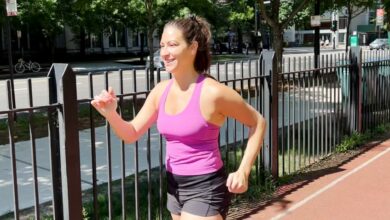I have heard so many creative–and uncreative–excuses from clients who stopped coming to the gym or showing up to fitness class. Some complain about workloads, others blame it on the school season, with children having to be picked up, fed and helped wtih homework.
But do these excuses justify us forgetting about fitness and health care?
There are no excuses to get out of the following 30-minute routine, which you can do at home with nothing more than some music and energy. This routine will help you keep in shape, feel good about yourself and–perhaps most importantly–doesn't require much time or even fitness expertise.
This routine should not, however, take the place of gym hours or fitness classes–it's more of a fitness-keeper than a fitness-provider. You can use this routine to maintain your current level of fitness while you're busy with other commitments.
Warming up
You need to warm up your body before you start doing any heavy exercise. It’s the best way to protect your muscles from possible injury and prepare your circulatory system for the upcoming workout.
Warm-ups are easy: you can march on one spot for two minutes before you start running for three more minutes. You might like to do some leg curls for two minutes followed by some knee lifts for three more, or you can skip–jump the rope for two minutes then run the rope for three. Whatever you do to warm your body should start at an easy rate and develop into a more difficult training.
Tip: Warming up can be extremely boring, so pick a fast song that you like and play it out loud for motivation.
Lower body movements
Without any weights to lift at home, you need to use your own weight to exercise. Lower-body muscles, then, are a better option for working out in the house as you'll be using your own weight to lift if you are using them right.
Start by doing some squats: Place your hands across your chest, then from a standing position, with feet about shoulder-width apart, squat down. Make sure, however, that your knees never go beyond 90 degrees (or you can make sure that your knees are not out past your toes as you descend).
Hold in the lower position for a number of seconds, then use your lower-body muscles (quads, hamstrings and glutes) to power yourself up to a standing position. Then repeat.
You can also do some lunge-backs: Place your hands on your hips and stand in a comfortable position with your feet shoulder-width apart. From this position, you should take your right leg straight back and move it as far back as possible without moving your left foot. Make sure, as well, that when you finally place your right foot on the floor behind you, your left knee is at 90 degrees (or at a straight vertical line with your ankle). In this position, you can lower your body slowly down in a balanced way (make sure you keep your balance by keeping your tummy in). Slowly bring back your right foot from behind, place it in its original spot, and repeat the same on your left.
Both the squat and the lunge-backs could be repeated up to 20 times.
Upper Body Movements
Again, to perform exercises without weights, you need to use your own body weight, and that is a bit tricky with the upper body muscles. While most people think of push-ups as an single exercise, this simple workout can benefit multiple upper body muscles with only small changes.
Push-up for the chest: While most push-up positions work on the triceps (the muscle in the back of the upper part of your arm), you can include your chest muscles in the workout by placing your arms wide apart. Isolate your triceps. You can work solely on your triceps by bringing your grips closer to each other, placing them on the floor in a way that your thumbs and your index fingers form a triangle underneath your chest.
Both exercises can be repeated up to 20 times.
Work on your torso:
The torso area is not just your abs muscles. After you do a run of abs exercises, such as normal ab curls and curls to the side, you should as well work on your back muscles. Lay on the floor facing down, and nail your feet to the floor, making sure you don't move them at all throughout the exercise. From there, start lifting your upper body by using your lower back muscles–but without harming yourself. You should not lift your body in an unnatural way. Repeat this workout for as many times as you did the ab curls.
Cool down
After finishing your workout, you shouldn't go on with your day without calming your body down. Start by stretching your muscles slowly and taking deep breathes to insure your system is back to normal. Finally, take a rest for three to five minutes by laying still on the floor.




